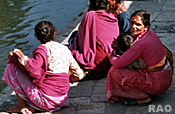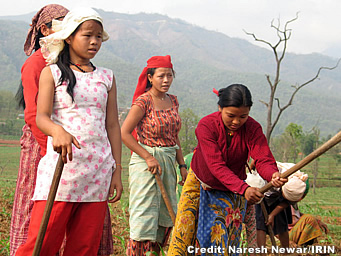 |
Nepal SOCIAL LIFE Children |
|
 |
Nepal Information |
|
|
 |
|
Girls worst exploited as child labourers
|
 |
KATHMANDU, 27 January 2011 (IRIN)
 |
|
One million fewer children are working in Nepal than a decade ago, though more girls are toiling in dangerous conditions than boys, according to a soon-to-be-published report documenting the country's sizeable population of child labourers.
Nearly 24 percent of girls nationwide (or 911,000), compared to 17.5 percent of boys (or 688,000), perform work that qualifies them as labourers, according to an International Labour Organization (ILO) report. |
|
Girls are 50 percent more likely to be involved in hazardous work - 373,000 girls, compared to 248,000 boys - exposing them to "significant" physical and psychological dangers, according to the study.
Madhav Pradhan, president of Child Workers in Nepal, a local child rights NGO, said traditional attitudes favour educating boys, who are seen as a family's future breadwinners.
ILO estimates there are 7.7 million children aged 5-17 in Nepal. According to the group, 1.6 million of them perform work that qualifies them as child labourers by international legal standards - one million fewer than in 1999.
A violent decade-long standoff between the state army and Maoist insurgents pushed rural families to send their children to the safety of urban areas where they subsequently worked to support themselves, but the practice has declined since fighting stopped in 2006, say observers.
While girls bear the brunt of labour, there has been a marked decline in 'kamlari', outlawed in 2006, where parents loan their children - usually girls from the Tharu caste - as indentured workers to pay off a family debt, say rights groups.
Rights groups have tried to discourage the practice by giving poor families grants, and the government has pledged financial assistance, said Pradhan.
Aggravating the problem is the fact that most children do not receive an education beyond primary school, and lax law enforcement allows factories to employ many of them despite a national ban, said ILO.
Source:IRIN 2011
Copyright
© UN Office for the Coordination of Humanitarian Affairs 2007
[
This report does not necessarily reflect the views of the United Nations]
Integrated
Regional Information Networks (IRIN), part of the UN Office for the Coordination
of Humanitarian Affairs (OCHA). |
 |
top
|
related information
|
 |
|
Links
|
 |
 |
 |
Externe
Links |
|




